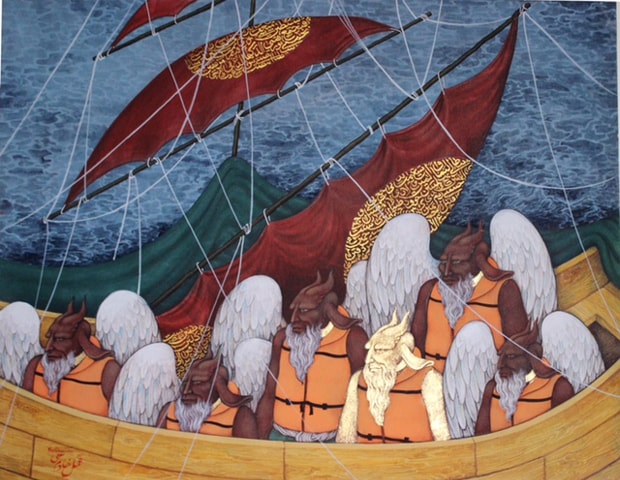
In its evolution over the last 20 years, miniature art has emerged with an identity that seems to simultaneously defy and embrace the traditional practice. Post 9/11, miniature has grown with a strong awareness of the human condition in the midst of continuous global conflict and the dynamics of power.
Displacement found form in miniaturist Tazeen Qayuum’s installation, ‘Holding Pattern’ at the Toronto Pearson airport departure lounge (2014). Qayuum’s repeated image of a cockroach in red, formed an intricate pattern that evolved from her earlier work on the killing of people in the Iraq War. The lattice or jaali became a window to a larger critique on terror/war.
In his earliest works, titled ‘Qaeedae- Rivazi’, held at Chawkandi Art, Karachi (2005), the miniaturist Khadim Ali illustrated the ‘quaida’, in which Urdu alphabets took on new meaning akin to the association of violence in an Afghanistan that he saw his cousins growing up in and learning to read.
There was a disparity in what they were learning and the gruesome reality they witnessed in real life. In Ali’s ‘Qaeedae- Rivazi’, the Urdu letter ‘bay’ stood for barood or gunpowder, the ‘alif’ for the word aslaha or weaponry.
Khadim Ali’s paintings reinvent the grandeur of the epic Shahnameh of Firdousi
Many years later, having attained prominence as an internationally acclaimed artist, Khadim Ali comes to Chawkandi Art, Karachi, with a heavyweight solo exhibition titled 'The Otherness'.
Ali explores the central protagonist of the epic Shahnameh, written against Arab dominance, by Hakim Abul Qasim Firdousi Tusi in Duree (pre-Persian language). Rustom was seen as the upholder of justice. Shahnameh is also a book that the artist grew up reading, for it was one of the few things that his grandfather took with him to Quetta when the family fled their home.

Zohra Hussain at Chawkandi Art narrated how Ali once, on a journey, witnessed the Taliban shouting the slogans, ‘We are the Rustoms of Islam / We will fly and attack the Hazaras.’ It struck him as strange that the Taliban associated themselves with the character of Rustom. To Ali, however, Rustom was ‘a failure’. And perhaps it is the contradiction in this reading of the legend of Rustom that Ali’s reinvention of the Shahnameh stories — which contain more than 60,000 verses — that compels his endless imagery around the metaphoric use of the figure of Rustom.
In the current artworks, as well as an on-going process, the artist seems to link the character of Rustom to many faces, nationalities, and times. It is the refugee exodus of Europe, the fleeing in boats, caught in a tempest. Signified by a web of ropes that tangle, disconnect and overlap, the imagery of ropes and markings suggests the conflict of displacement, but also a clear indication of new journeys.
Does Rustom emerge in Ali’s imagery as the trumpet or bugle-bearing flying Taliban, the reclining figure recalling the destruction of the Buddhas in Bamyan? And is this also a manifestation of the artist’s own self? The character appears pensive, violent, sometimes mischievous and, at times, a voyeur detached from its immediate physical reality.
Some connections, perhaps not so distant, can be made in the prize-winning courtyard, ‘Blessings Upon the Land of My Love’ by Imran Qureshi at the Sharjah Biennial in 2011. Qureshi converted the courtyard of a three-story building of a former hospital into what appeared like a blood-stained massacre site to collectively mourn the killing in the region. In this instance, Qureshi also seems to play the role of the storyteller, much like the marsiya-khwaan who retell the story of sacrifice and pain at Karbala for their audience. It is this kind of juxtaposition of histories of different eras that also come together in Khadim Ali’s imagery.
Khadim’s use of the colour red, in the work under review, is of deeper density, than compared to the bright red in his earlier works of ‘Qaeeda-e-Rivazi’ and ‘Jashn-e-Gul-e-Surkh’ (Celebration of Red Tulips, 2004) — both shown at Chawkandi Art. Whether it became visible consciously or subconsciously from the stories of his elders, his own experiences of Talibanisation or from the training of his mentor Imran Qureshi at Lahore’s National College of Arts, the colour red forms a strong centre that seems to hold the grandeur of the gold leaf in this contemporary reinvention of the epic of Shahnameh.
The most moving aspect of a compelling narrative is always its ability to take the viewer on many simultaneous journeys. The visible image, which Khadim Ali paints with the meticulous perfection of the master illustrators of the Shahnameh, is but a window into a seething critique of the ‘Rustoms’ of his times.
Published in Dawn, EOS, July 16th, 2017















































Dear visitor, the comments section is undergoing an overhaul and will return soon.